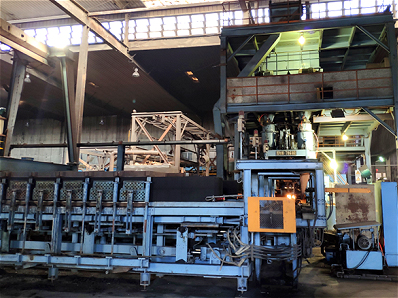
Vertical Parting Flaskless Molding uses a special mold structure during casting so that the casting direction is 90 degrees perpendicular to the stress direction. It can not only greatly improve the compactness and tensile strength of the casting, but also control the cooling speed and prevent the casting defects, so it is widely used in various industrial manufacturing fields.



Strong filling ability:
The fluidity and gravity of the molten metal during the casting process are used to make it flow from bottom to top in the vertical direction, so that the gas and impurities inside the casting can be easily eliminated.
Improve the casting quality:
The Vertical Parting Flaskless Molding Line can greatly improve the compactness and tensile strength of castings and other performance indicators, thereby making the castings have better quality.
Reduce casting defects:
Because the Vertical Parting Flaskless Molding Line can control the cooling rate of the casting, it reduces the occurrence of casting defects, such as holes inside castings.
Reduce production costs:
The Vertical Parting Flaskless Molding Line can reduce the generation of scrap castings, thereby reducing production costs and waste of resources.
Achieve the high-speed casting, stable casting molding, and precise control of material usage and production costs.
Customized design according to the actual needs of customers.
During casting, the molten metal flows from bottom to top, and the gas and impurities inside the casting are easily eliminated, thereby making the molding stability of the casting is higher.
There is no need to use auxiliary means such as pressure or vacuuming. The metal material can fill the entire casting shape by gravity, which facilitates the production of castings with complex shapes and improves production efficiency.




Mold preparation:
According to the shape and size of the casting, select a suitable mold and apply a layer of release agent inside the mold to prevent the casting from adhering to the mold.Smelting molten metal:
According to the material and quality requirements of the casting, select appropriate metal materials, and smelt and adjust them in the furnace to obtain a suitable molten metal state.Pouring:
Pour the molten metal into the mold and wait for it to cool and solidify within a certain period of time. During the pouring process, attention needs to be paid to controlling the temperature and flow rate of the molten metal to avoid defects or deformation.Cooling and demolding:
After the casting is fully cooled, open the mold and take out the casting. At this time, you need to pay attention to the temperature of the casting and the mold to avoid deformation of the casting or damage of the mold due to excessive temperature differences.Trimming and processing:
For some castings that are of unqualified quality or require further processing, subsequent trimming and processing are required to meet the product quality requirements.

| Type |
Molding room size |
Capacity |
Sand consumption |
Power |
| XKZZ416A | 600*500 | 250 | 12-15 | 22 |
| XKZZ416B | 650*535 | 300 | 20-35 | 42.5 |
| XKZZ417B | 700*535 | 250 | 20-35 | 55.5 |
| XKZZ418B | 800*600 | 220 | 25-40 | 75 |
*The output will vary according to different materials, feed particle size and other factors
Save Time! Get A Detailed Quotation Quickly.
